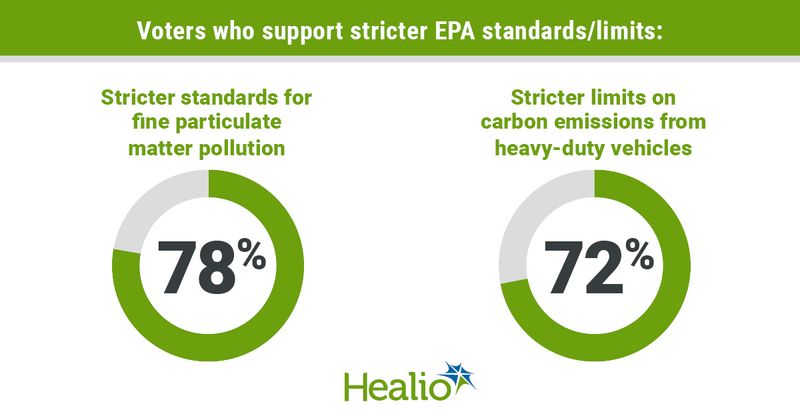Many voters support stricter fine particulate pollution, truck emission standards
Click Here to Manage Email Alerts
Key takeaways:
- More than 70% of registered voters support the call for stricter fine particulate pollution standards and truck carbon emission limits.
- Support was high for these rules even after a balanced debate.
When asked if they support or oppose stricter fine particulate pollution standards and limits on truck emissions, many voters voiced their support, according to poll results from the Global Strategy Group for the American Lung Association.

“What our new polls found is that overwhelming majorities of people support EPA’s tighter limits on particle pollution and measures under consideration to reduce greenhouse gas emissions from future trucks,” Laura Kate Bender, national assistant vice president of healthy air at the American Lung Association, told Healio. “More than two thirds also see each of these standards as beneficial for the health of families like theirs.”

Using results from two surveys conducted between Jan. 29, 2024, and Feb. 5, 2024, the American Lung Association assessed the public’s view on the EPA’s recent finalized change to the annual National Ambient Air Quality Standard for fine particulate matter (soot) pollution and the EPA’s standards to reduce carbon emissions from trucks.
The survey on stricter standards for particle pollution included 799 individuals registered to vote, whereas the survey on emission limits for trucks included 801 registered voters.
Soot pollution survey
In the first survey, support for stricter standards for fine particulate matter was more common than opposition (78% vs. 13%). Support remained high across racial/ethnic groups (white, 77%; Black, 84%; Hispanic, 75%) and was found more often than opposition across political parties (Democrats, 90%; independents, 67%; not very conservative Republicans, 71%; very conservative Republicans, 61%).
When asked about the impact stricter standards for this type of pollution would have on air quality, most responded saying a positive impact (77%). The survey also found that individuals commonly believed that stricter standards would positively impact future generations of Americans (73%), communities impacted the most by pollution from fossil fuels (70%) and “the health of families like yours” (73%).
In terms of money, 72% of individuals believe stricter standards would have a non-negative impact on the economy (38% believing it would have a positive impact; 34% believing it would have no impact/not sure).
This stance was also seen when researchers divided the population by race/ethnicity, as more Black individuals and Hispanic individuals responded with positive impact vs. negative impact (Black, 53% vs. 19%; Hispanic, 36% vs. 26%).
“It’s not a surprise that the public continues to support stronger limits on air pollution,” Bender said. “The Lung Association has released several polls over the years, and we’ve consistently found that voters support measures to reduce air pollution.”
In an effort to see if hearing arguments for and against stricter fine particulate matter standards changes an individual’s stance on the topic, participants listened to a simulated, balanced debate, which Bender said reflected “what’s actually being said in the real world.”
The American Lung Association reported that support for stricter soot standards remained high (68%) even after hearing both sides of the debate.
“When our pollsters asked voters to choose which messages they agreed more with — positive messages about the health benefits of the standards or opponents’ claims of economic harm — two-thirds sided with the health messages,” Bender said.
This survey also asked individuals whether they support or oppose three stricter emissions standards currently being considered by the EPA. According to the results, support was high for stricter limits on mercury and other toxic air emissions from power plants (82%), carbon emissions from new and existing power plants (76%) and smog from power plants, oil refineries and other industrial facilities (78%).
Heavy-duty vehicle emissions survey
Similar to the first survey, support for stricter limits on carbon emissions from trucks appeared more frequently than opposition (72% vs. 20%), and support was high among white voters (69%), Black voters (78%) and Hispanic voters (75%).
Researchers also observed more support vs. opposition among Democrats (90%), independents (67%) and not very conservative Republicans (60%), with lower levels of support among very conservative Republicans (36%).
Further, placing stricter limits on truck carbon emissions was believed by many to have a positive impact on air quality (76%), future generations of Americans (71%), communities impacted the most by pollution from fossil fuels (68%) and “health of families like yours” (67%).
When asked about the impact these limits would have on the economy, 63% said a non-negative impact, which included 36% believing it would have a positive impact and 27% believing it would have no impact/not sure. The remaining 37% said a negative impact.
The belief that stricter limits on carbon emissions from trucks will have a positive impact on the economy rather than a negative impact was frequently found among Black (50% vs. 21%) and Hispanic (48% vs. 25%) individuals.
Researchers behind this survey also reassessed feelings toward stricter limits after participants read statements for and against these limits and found a high percentage of individuals who supported (67%) or strongly supported (33%) harsher limits.
Notably, support levels for stricter limits on light-duty vehicle emissions and waivers that allow California to implement its own stronger limits on vehicle emissions were both over 50%, according to survey results.
The last main finding from both surveys was the high percentage of individuals (83%) who voiced their support for prioritizing standards that clean up the most polluted neighborhoods in America. Notably, support for this notion was high in the three political parties assessed (Democrats, 92%; independents, 76%; Republicans, 74%).
“These stronger clean air standards aren’t just important for health in general, they’re also critical for health equity,” Bender told Healio. “We know that people of color are disproportionately exposed to sources of air pollution. Making strong rules to clean up those polluting sources is critical for reducing health disparities.”
Role of clinicians, future research
When interpreting results from both surveys, Bender said clinicians should remember that they are powerful figures who can spark change.
“Clinicians play a critical role in helping patients understand the risks that air pollution and climate change pose to their health,” Bender said. “They also play a critical role in advocating for solutions, not just persuading patients but also advocating for policy change. The stories of impacts that clinicians share puts a human face on the issue for policymakers that helps drive action.”
Future surveys/polls will continue to capture how the public feels about EPA standards, with hopes that the observed strong support for various stricter rules will fast-track finalization, Bender added.
“What we hope to achieve, in part by highlighting the results of these latest polls, is that EPA finalizes all of the standards we polled on,” Bender said. “They need to build on the groundwork they laid with finalizing stronger particulate matter standards and get the rest of these rules across the finish line to clean up cars, trucks, power plants and ozone smog.”
References:
- ALA heavy duty vehicles nationwide memo. https://action.lung.org/site/DocServer/ALA_Heavy-Duty_Vehicles_Nationwide_Memo_F02.29.24.pdf. Accessed March 7, 2024.
- Nearly 80% of voters support EPA’s stricter standards for particle pollution, according to new poll. https://www.lung.org/media/press-releases/nearly-80-of-voters-support-epa%E2%80%99s-stricter-standa. Published March 5, 2024. Accessed March 5, 2024.

